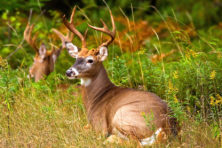Wildlife Hibernation
- Share
- Tweet
- Pin
- Share
Late last September through October and into early November was when the internal clocks of quite a few wild creatures were sending important messages to their brains. It was time to search for a warmer wintering site, such as an unused burrow dug by another animal or an old empty well. These are the wildlife that get turned off to winter.
Even though many mammals of this region disappear from sight for several months of the winter, they don’t hibernate any more than people who remain in their homes or, better yet, travel to the South where the air is warm and the food is good.
Take a Chipmunk for example. Those in our yard usually retire by early November when continuous freezing occurs. The first “Chippie” of the spring may appear as early as the second week of March, as fleet-footed and pert as the day he thumbed his nose at winter and vanished underground.
Their so-called hibernation can be quite variable. My wife’s folks lived near Milwaukee in past years and had Chipmunks in their backyard coming out for food during most weeks of winter. These well-liked little mammals go into a fairly normal slumber in their underground chamber quite possibly on top of their food caches.
Thirteen-lined Ground Squirrels – commonly referred to as Gophers in our region – are true hibernators. They may spend as much as seven months of each year in their subterranean winter quarters. Studies show that their winter body temperature drops to only a few degrees above freezing. Imagine an annual temperature range from about 36 degrees in winter to 105 degrees in summer! Their heartbeat falls from between 200 to 400 per minute in summer to about five beats per minute in winter.
North and Central America lay claim to about 3,700 of the world’s 17,000 to 18,000 mammals. Eastern Wisconsin lists about 34 wild mammals. Twenty-six of these remain active throughout the year. They include the White-tailed Deer, Coyote, Cottontail, all Squirrels, Deer Mouse and Shrew. Others in this active group are the Beaver and Muskrat, whose activities are confined to that zone beneath the snow and ice. As a matter of fact an adult Muskrat can swim as much as 180 feet under water while remaining submerged for up to 15 minutes.
Six species go into a normal slumber and generally remain out of sight for most of the winter. They are the Chipmunk, Badger, Skunk, Bear, Opossum and Raccoon. The Raccoon, like the Black Bear, accumulates plenty of fat and then goes into a sleeping period. They will occasionally venture out during warm winter days. Bears, while in torpor, don’t urinate or defecate from fall to spring. Their wastes are recycled back into more protein.
A Woodchuck (or Groundhog), for example, is known to dig quite an elaborate tunnel below the frost line, perhaps on a rocky hillside. There it will retire at a time when there still is a plentiful supply of food available. Somehow these animals can sense when they’ve stored enough sustenance for them to endure the cold season.
Frogs, snakes, turtles and other cold-blooded animals will obviously need a warmer environment in which to endure sub-freezing outdoor temperatures. They will slowly grow colder instead of struggling to stay warm like humans and many other animals.
Actually very few warm-blooded animals enter a true state of hibernation. Included in this select group are the 13-Lined Ground Squirrel, Woodchuck and the Bats. Complicated body changes will occur involving the amount of insulin in the bloodstream, functions of body muscles and brain, and the elimination of body wastes.
Some of the Bats of our region will migrate short distances in search of warmer winter sites while others will winter here, such as in your attic where the temperature will remain above freezing. The Brown Bat will have approximately doubled its weight from its one-third ounce in spring to its fall weight of two-thirds of an ounce. In fact this doubling of body weight is similar to other true hibernators as well.
The Bat’s normal breathing rate of 200 breaths per minute will be reduced to about one breath every five minutes. A normal summer temperature of 104 degrees will now hover near 42 degrees. It is only this hibernating temperature that will prolong the lifespan of a Bat up to 15 years, compared to the high-strung non-hibernating Shrew that will be lucky to reach one and one-half years of age.
Bats are also known to experience a considerably lower daytime temperature during the summer, thereby also helping them to conserve energy. Hummingbirds, in order to conserve energy during the night, have their body temperature dipping by as much as 50 degrees lower than is normal.

Hans Martin sits next to a tranquilized Mama Black Bear. Submitted photo.
Studies have shown that when invertebrates, such as flies and butterflies, do “freeze,” only about one-half of their body fluids freeze. As long as their vital inner body fluids remain unfrozen the insects will survive in a dormant state.
Our friend Hans Martin, who is studying to be a Wolf biologist, recently volunteered to help with Black Bear research. He crawled into a bear den and helped remove a tranquilized female Black Bear and three cubs. They were measured and tagged and returned to their “sleeping quarters.”
Soon we will see the Woodchucks brought out of their enclosures to celebrate Groundhog Day. They will help us think about the coming spring and then be set back into their comfy winter homes until the real warm weather arrives, in perhaps six weeks.
That reminds me. It’s about time to load a few more chunks of hardwood into the cast iron stove that helps keep us warm.


